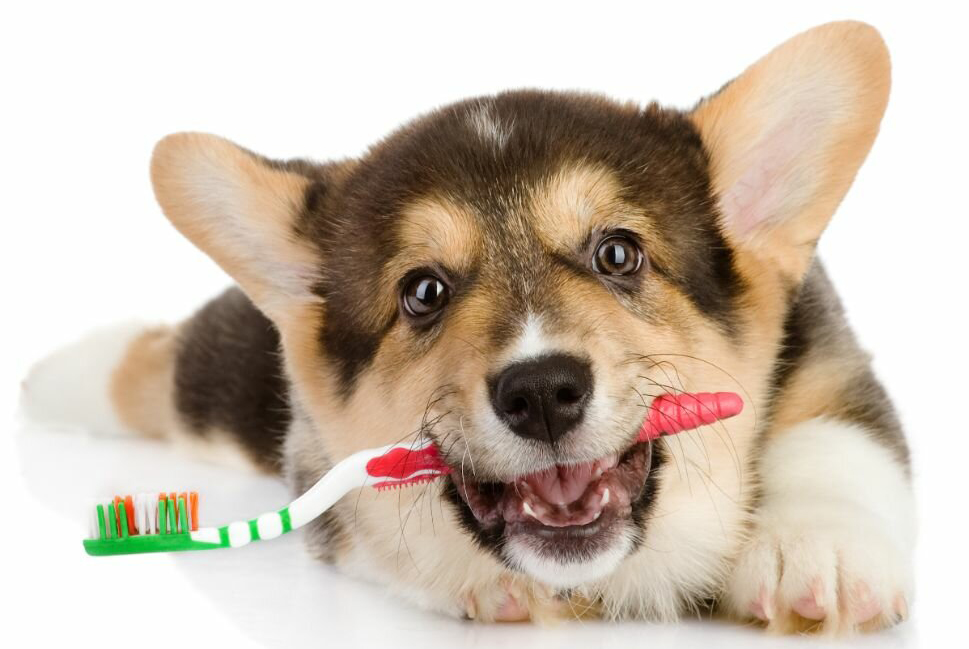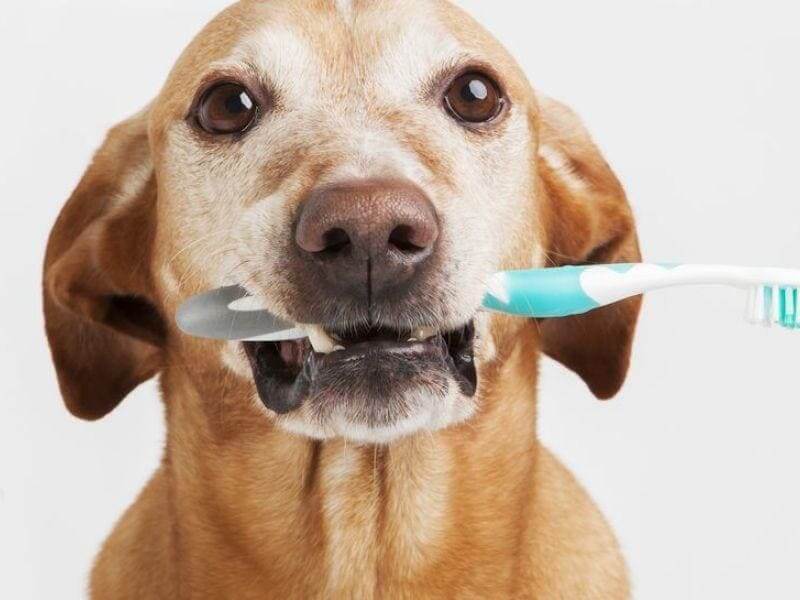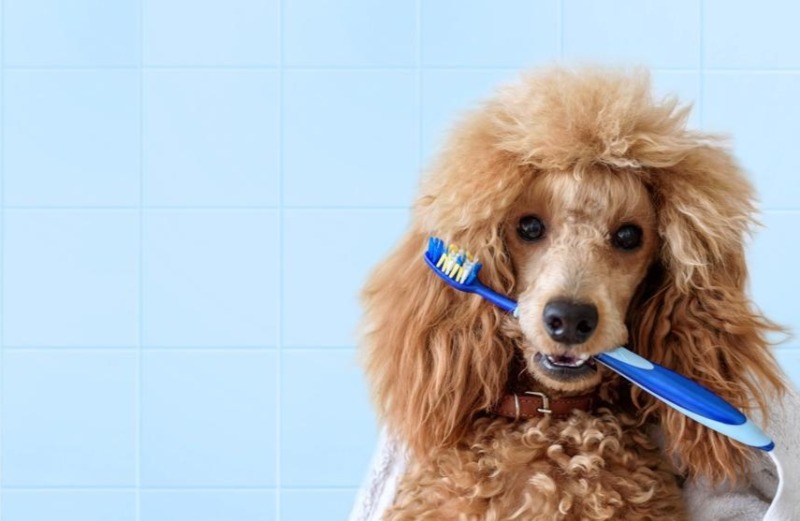Brush the dog’s teeth? Isn’t that an exaggerated anthropomorphization? No, dogs are less likely to suffer from tooth decay than humans, but they can get periodontal diseases like gingivitis and periodontitis just as easily. Diseases of the periodontium due to misaligned teeth are also not uncommon. It is possible that today’s four-legged friends are just as affected by the consequences of an unhealthy lifestyle as we are. Nature has armed dogs against bacterial attacks with a strong salivation, but they cannot withstand all modern challenges. Poor nutrition, too little exercise and unsuitable toys that damage tooth enamel are among the most common causes of mouth diseases. Brushing a dog’s teeth is, in addition to preventive measures, an important contribution to health care. You can find tips on how to brush your dog’s teeth in this article.
Brushing the Dog’s Teeth: Why Dental Care is Important in Dogs

A dog’s teeth serve as a deterrent, as a hunting weapon and as an eating tool all in one. When eating, deposits form on the teeth, the so-called soft plaque is formed. Bacteria can multiply here unhindered and form solid tartar over time. Bacteria can also nest in the gum pockets, which in the long run can cause gingivitis and periodontitis. Dogs are somewhat better protected from attackers than humans because of their distant teeth, because the saliva can run unhindered through the gaps and kill bacteria. But only when a dog runs or rages does the saliva flow freely. Dental disease affects more than 80% of our pet dogs today. Dog owners must not rely solely on nature.
How often do I have to brush my dog’s teeth?
Brushing your dog’s teeth every other day is enough. In between, he may occasionally gnaw on dental care toys, a bone, or a chewing stick.
Evidence of bad teeth
Poor oral hygiene in dogs can easily be recognized by yellowish to brownish deposits on the teeth. The soft plaque usually forms first at the lower edge between the tooth and gums. Bad breath is also a common early sign of dental disease. Periodontitis is initially noticeable through reddened gums, which swell, become painful and possibly bleed as the stage progresses. In addition, plaque and tartar build up. As the disease progresses, the teeth become looser and the dog has trouble eating. If, for example, a four-legged friend only chews his food hesitantly, puts a chunk in his mouth and immediately drops it again, whines when he bites it, only chews on one side or reduces his food intake altogether, these are alarm signs.
How do I keep my dog’s teeth clean?
To prevent plaque from forming in the first place, the dog should be fed a low-sugar diet, chew on bones or suitable toys regularly and move around a lot. Brushing your teeth every two days and an annual visit to the vet round off perfect oral hygiene.
Brushing the dog’s teeth – utensils

Dog teeth, like human teeth, develop in three phases. After the puppy is born toothless, it develops its milk teeth up to the sixth week of life. He keeps the deciduous teeth until about the fourth to seventh month before they are replaced by the permanent teeth. The change of teeth in dogs is usually uncomplicated, but at this stage regular dental care is necessary. The most important utensils for this are special toothbrushes and toothpaste to brush the dog’s teeth.
Dog toothpaste
Human toothpaste is not suitable for dogs because some of the ingredients in it are not good for the animal, such as xylitol. Products made especially for dogs or even homemade dog toothpaste are harmless. Coconut oil, with its antibacterial properties and neutral taste, is a good base for a homemade paste. A dash of lemon juice can also have a slight lightening effect, and you can also add a small amount of peppermint or parsley as a breath freshener.
Can I brush my dog’s teeth with toothpaste?
Toothpaste for humans is not suitable for brushing a dog’s teeth, as it may contain ingredients that are intolerable for him. A special dog toothpaste or the home remedy coconut oil is recommended.
Dog toothbrush
A toothbrush specially developed for dogs is characterized by the fact that the head is not too big and the bristles are not too hard. It is also designed so that people can hold it comfortably. There are dog toothbrushes with a particularly long handle that is easy to grip. There are also finger toothbrushes on the market that have a small loop on the side or that can be put on the front of the finger as a finger stall. Dog toothbrushes are available in different sizes and should be selected according to the size of the dog’s mouth.
Today there are also electric toothbrushes for dogs. Their advantage over manual toothbrushes is that they clean with less pressure. This will prevent gum irritation from scrubbing too hard. However, some dogs do not like the vibration of electronic device. Whether manual or electric cleaning works better depends entirely on the dog.
Toothpaste flakes
If you find it too cumbersome to brush your dog’s teeth, you can use tooth cleaning flakes to boost the cleaning of the teeth. The treats, made from natural ingredients and enriched with vitamins and minerals, are given to the dog with the food or as a dessert. About one to two teaspoons a day is enough. The paste spreads in the mouth, preventing the spread of bacteria and thus counteracting the formation of plaque and tartar. It also has a slightly abrasive effect, sanding away the first deposits from the teeth when chewing.
What is the point of brushing your dog’s teeth?
Brushing can remove the plaque on your teeth where bacteria can settle and multiply. Clean teeth protect against tooth and gum diseases such as inflammation and periodontitis.
Chewing sticks
Other easy-to-use aids are chewing sticks with a dental care effect. Intensive chewing stimulates the flow of saliva, so that germs and bacteria are naturally flushed out of the spaces between the teeth. When choosing chewing sticks, however, you should pay attention to the ingredients. Many industrially manufactured products contain a lot of sugar or other unhealthy and high-calorie components. Products with a low sugar and fat content are more suitable.
Toothbrush toy

Dental toys such as balls, play ropes and rubber bones can also strengthen the jaw muscles, stimulate salivation and grind away plaque. A natural bone, however, fulfills the same purpose: if a dog gnaws it intensively, it automatically cleans its tooth surfaces, while the strongly flowing saliva also acts against bacteria. However, aids such as chewing sticks or toys are not a complete substitute for regular brushing and cannot replace a thorough cleaning at the vet’s. Because existing tartar cannot be removed with it. However, toys can make a useful contribution as a supplement to mouth care.
How do you brush puppies teeth?
A puppy doesn’t need dental care until it loses its milk teeth. But he can practice a little beforehand. If he is allowed to lick a finger with dog toothpaste, he adjusts to the taste and will later be more willing to have his teeth cleaned.
Brush your dog’s teeth: step-by-step instructions
The four-legged friend does not yet understand what his master or mistress is asking of him when he first tries to brush his teeth. Each dog must be introduced to the procedure slowly and gently. The best learning success is achieved by those who get their darling used to brushing their teeth when they are still puppies.
1. Taste test: First, the dog is allowed to lick a finger with dog toothpaste or homemade dog toothpaste. It turns out immediately whether this taste convinces the four-legged friend.
2. Brushing with the finger: In the second experiment, the dog is allowed to keep its mouth closed while a finger slides carefully under its upper lips and rubs the outside of the incisors with toothpaste. If the dog puts up with this teeth cleaning without snapping, it can move on to the molars.
3. Use of the toothbrush: Now the animal can get used to the toothbrush. First, the longest tooth (fang) on both sides is cleaned.
4. Brush molars: When the dog has developed trust, got used to the first brushing and no longer finds the cleaning threatening, it can open its mouth slightly so that the toothbrush can also reach the molars.
5. Complete teeth cleaning: Now the dog is ready for a complete tooth brushing cycle, which is best always started with the fangs. Then come the incisors and finally the more difficult to access molars. Dental care is done!
What helps prevent dental disease?

Not only humans, but also dogs should go to the doctor regularly for a dental examination. Only the veterinarian can professionally remove stubborn plaque and tartar. It also recognizes misaligned teeth or gum diseases that require treatment. In addition, dog owners can promote their dog’s oral health in a natural way with the right diet and plenty of exercise. The food should be largely sugar-free, and dietary supplements with ingredients that care for the teeth can also help. If you then brush your dog’s teeth every other day, you have done your best.



























